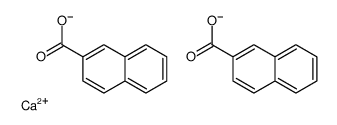Calcium naphthenate
Modify Date: 2024-01-09 11:34:46

Calcium naphthenate structure
|
Common Name | Calcium naphthenate | ||
|---|---|---|---|---|
| CAS Number | 61789-36-4 | Molecular Weight | 382.42200 | |
| Density | N/A | Boiling Point | N/A | |
| Molecular Formula | C22H14CaO4 | Melting Point | > 100ºC | |
| MSDS | N/A | Flash Point | combustible | |
| Name | calcium,naphthalene-2-carboxylate |
|---|---|
| Synonym | More Synonyms |
| Melting Point | > 100ºC |
|---|---|
| Molecular Formula | C22H14CaO4 |
| Molecular Weight | 382.42200 |
| Flash Point | combustible |
| Exact Mass | 382.05200 |
| PSA | 80.26000 |
| LogP | 2.40660 |
|
Section 1: Product Identification Chemical Name:Calcium naphthenate, approx. 35% in mineral spirits (4% Ca) CAS Registry Number:61789-36-4 Formula:Ca salt of naphthenic acid EINECS Number:263-055-1 Chemical Family:metal carboxylate Synonym:Naphthenic acid, calcium salt, in petroleum spirits, paraffin oil.
Section 2: Composition and Information on Ingredients IngredientCAS NumberPercentACGIH (TWA)OSHA (PEL) Title compound61789-36-435%no datano data mineral spirits64475-85-065%no datano data Section 3: Hazards Identification Emergency Overview:Vapor is irritating to eyes, skin and respiratory tract, and cause drowsiness. May be harmful if swallowed. Primary Routes of Exposure:Ingestion, eyes, inhalation, skin Eye Contact:Causes mild irritation of the eyes. Skin Contact:Causes slight to mild irritation of the skin. Inhalation:Vapor is irritating to the nose, mucous membranes and respiratory tract, and cause drowsiness. Ingestion:Ingestion may cause gastrointestinal distress, dizziness, weakness, and drowsiness. Irritating to skin, eyes and respiratory tract. Mineral spirits entering lungs during vomiting can cause severe Acute Health Affects: pulmonary injury. Chronic Health Affects:No data available NTP:No IARC:No OSHA:No SECTION 4: First Aid Measures Immediately flush the eyes with copious amounts of water for at least 10-15 minutes. A victim may need Eye Exposure: assistance in keeping their eye lids open. Get immediate medical attention. Wash the affected area immediately with water. Remove contaminated clothing if necessary. Seek medical Skin Exposure: assistance if irritation persists. Remove the victim to fresh air. Closely monitor the victim for signs of respiratory problems, such as difficulty Inhalation: in breathing, coughing, wheezing, or pain. In such cases seek immediate medical assistance. Seek medical attention immediately. Keep the victim calm. Give the victim water (only if conscious). Induce Ingestion: vomiting only if directed by medical personnel. SECTION 5: Fire Fighting Measures Flash Point:>100 °F Autoignition Temperature:445 °F (mineral sp Explosion Limits:0.7-8.9% in air (mineral s Extinguishing Medium:carbon dioxide, dry powder or foam If this product is involved in a fire, fire fighters should be equipped with a NIOSH approved positive pressure Special Fire Fighting Procedures: self- contained breathing apparatus and full protective clothing. Hazardous Combustion andIf involved in a fire this material may emit toxic organic fumes. Decomposion Products: Unusual Fire or Explosion Hazards: Flammable material. No unusual fire or explosion hazards. SECTION 6: Accidental Release Measures Eliminate all ignition sources. Small spills may be adsorbed into diatomaceous earth, sand, or other suitable Spill and Leak Procedures: adsorbent, and swept up. SECTION 7: Handling and Storage Handling and Storage:Store the material in a tightly sealed container in a cool, dry place. SECTION 8: Exposure Controls and Personal Protection Eye Protection:Always wear approved safety glasses when handling a chemical substance in the laboratory. Skin Protection:Wear protective clothing and gloves. Consult with glove manufacturer to determine the proper type of glove. Ventilation:Material may form a vapor. If possible, handle the material in an efficient fume hood. If ventilation is not available a respirator should be worn. The use of respirators requires a Respirator Respirator: Protection Program to be in compliance with 29 CFR 1910.134. Ventilation:Material may form a vapor. If possible, handle the material in an efficient fume hood. Additional Protection:No additional protection required. SECTION 9: Physical and Chemical Properties Color and Form:viscous liq. Molecular Weight:not applicable Melting Point:no data Boiling Point:no data Vapor Pressure:no data Specific Gravity:1.01 Odor:organic odor Solubility in Water:insoluble SECTION 10: Stability and Reactivity Stability:air and moisture stable liquid Hazardous Polymerization:no hazardous polymerization Conditions to Avoid:Keep away from heat and ignition sources including open flame and electrostatic discharge. Incompatibility:Oxidizing agents Decomposition Products:Carbon dioxide, carbon monoxide, organic vapors, and metal oxides and carbonates. SECTION 11: Toxicological Information Oral (rat); LD50:>6 gm/kg. For mineral spirits: Oral (rat); LD50: >34600mg/kg. Inhalation (rat); LC50: RTECS Data:>21400mg/m3/4H. Intraperitoneal (rat); LDLo: 8560mg/kg. Administration onto the skin (rabbit); LD50: 15400mg/kg. Carcinogenic Effects:No data available Mutagenic Effects:No data available Tetratogenic Effects:No data available SECTION 12: Ecological Information Ecological Information:No information available SECTION 13: Disposal Considerations Disposal:Dispose of according to local, state and federal regulations. SECTION 14: Transportation Shipping Name (CFR):Flammable liquids, N.O.S. Hazard Class (CFR):3 Additional Hazard Class (CFR):NA Packaging Group (CFR):III UN ID Number (CFR):UN# 1993 Shipping Name (IATA):Flammable liquid, N.O.S. Hazard Class (IATA):3 Additional Hazard Class (IATA):NA Packaging Group (IATA):III UN ID Number (IATA):UN# 1993 SECTION 15: Regulatory Information TSCA:Listed in the TSCA inventory. SARA (Title 313):Title compound not listed Second Ingredient:Listed in the TSCA inventory SECTION 16 - ADDITIONAL INFORMATION N/A |
CHEMICAL IDENTIFICATION
HEALTH HAZARD DATAACUTE TOXICITY DATA
|
| Calcium naphthenate |
| calcium(2+) bis(2-naphthoate) |